Introduction To Macros in Excel
In the world of Excel, macros are like magical shortcuts that can revolutionize your productivity. These powerful automation tools allow you to automate repetitive tasks, streamline complex processes, and save valuable time.
If you’re ready to take your Excel skills to the next level and become a master of macros, you’ve come to the right place. In this article, we will dive deep into the world of macros in Excel, equipping you with the knowledge and skills to boost your productivity and efficiency.
What Is Macros in Excel
Macros in Excel are a powerful feature that allows users to automate repetitive tasks and streamline complex processes. In simple terms, a macro is a recorded set of actions that can be replayed with a single click or assigned to a specific shortcut key. It acts as a time-saving tool, eliminating the need to manually perform repetitive actions over and over again. With macros, you can automate tasks such as data entry, formatting, calculations, and even generating reports.
Macros in Excel are created using Visual Basic for Applications (VBA), a programming language specifically designed for automating tasks in Microsoft Office applications. VBA allows you to write custom code that controls Excel’s functionality and perform complex operations that are not possible with standard formulas or functions.
By utilizing macros in Excel, you can significantly increase your productivity and efficiency. They enable you to complete tasks in a fraction of the time it would take to do them manually. Macros also reduce the risk of human error, ensuring consistent and accurate results. Whether you’re working with large datasets, creating complex spreadsheets, or performing repetitive calculations, macros can simplify your work and make your life easier.
It’s important to note that while macros can be incredibly useful, they require some basic programming knowledge to create and modify. However, even if you’re not familiar with coding, Excel provides built-in macro recording functionality that allows you to record your actions and generate code automatically.
Learn Excel
How Macros in Excel can Boost Productivity
Macros in Excel have the incredible ability to boost productivity and make any task easier and faster. By automating repetitive actions, macros eliminate the need for manual input, saving you valuable time and effort. Tasks that would typically take hours to complete can be done in a matter of seconds with the click of a button.
Imagine having to perform the same formatting or calculations on a large dataset repeatedly. With macros, you can record those actions once and replay them as many times as needed. This not only saves time but also reduces the risk of errors that can occur from manual data entry.
Furthermore, macros can simplify complex processes by condensing multiple steps into a single command. For example, generating reports that require pulling data from different worksheets or workbooks can be automated with macros. By writing custom code or recording your actions, you can create a macro that seamlessly retrieves and organizes the necessary information, eliminating the need for manual data manipulation.
Macros also allow for greater consistency and accuracy in your work. Since they follow predefined instructions, there is less room for human error compared to manual processes. This is particularly beneficial when working with large datasets or performing intricate calculations where precision is crucial.
Another advantage of macros is their versatility. They can be applied across various Excel functions, from data analysis to financial modeling to report generation. Whether you’re a business professional, analyst, or student, macros can streamline your tasks and make your work more efficient.
Cheat Sheets
Step-by-step Giide to create a Macro in Excel
Here’s a detailed step-by-step process to create a macro in Excel with an example:
Step 1: Enable the Developer Tab
- Open Excel and go to the “File” tab.
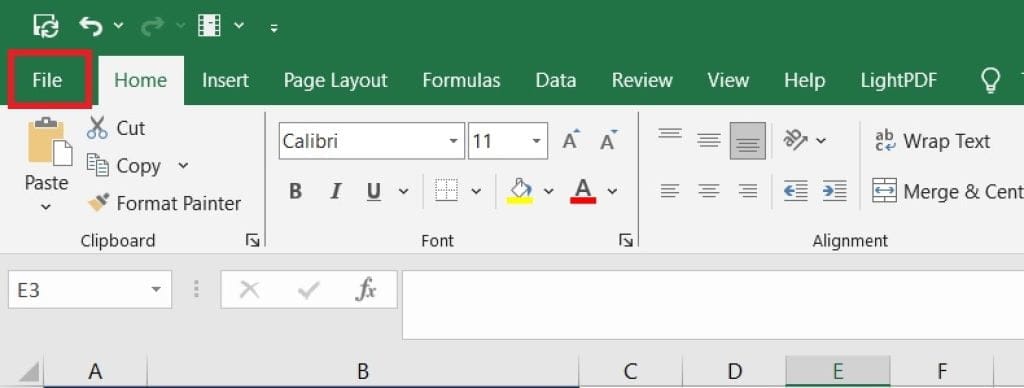
- Click on “Options” and select “Customize Ribbon.”
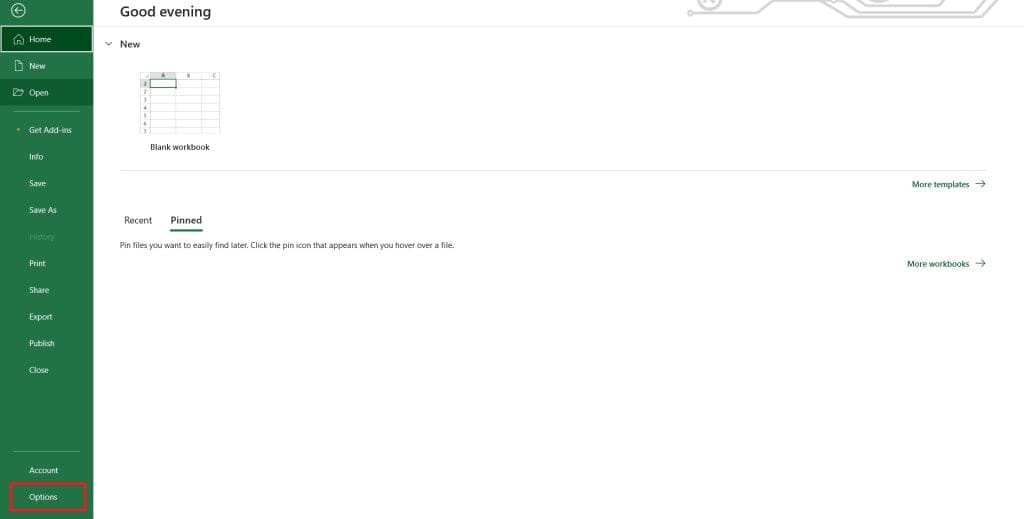
- In the “Customize the Ribbon” section, check the box next to “Developer” and click “OK.”
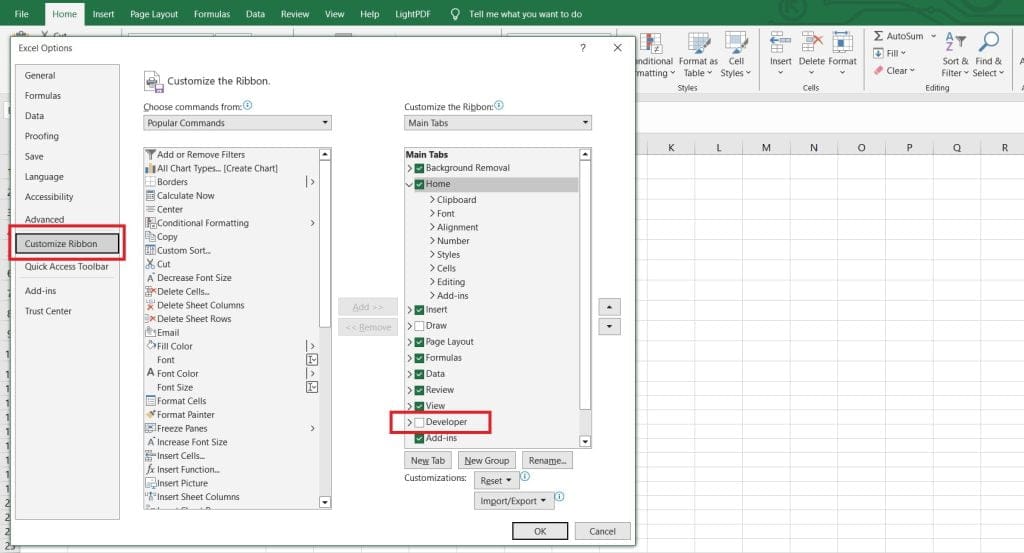
Step 2: Record the Macro
- Click on the “Developer” tab in the Excel ribbon.
- In the “Code” group, click on “Record Macro.”
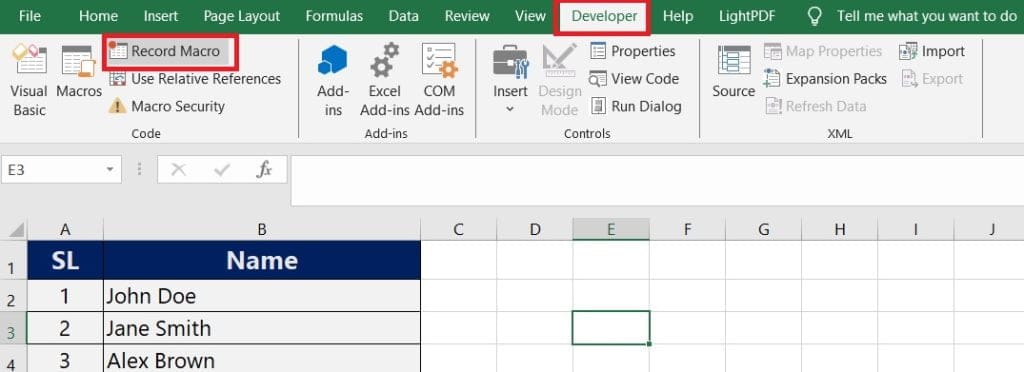
- In the “Record Macro” dialog box, enter a name for your macro and optionally assign it a shortcut key.
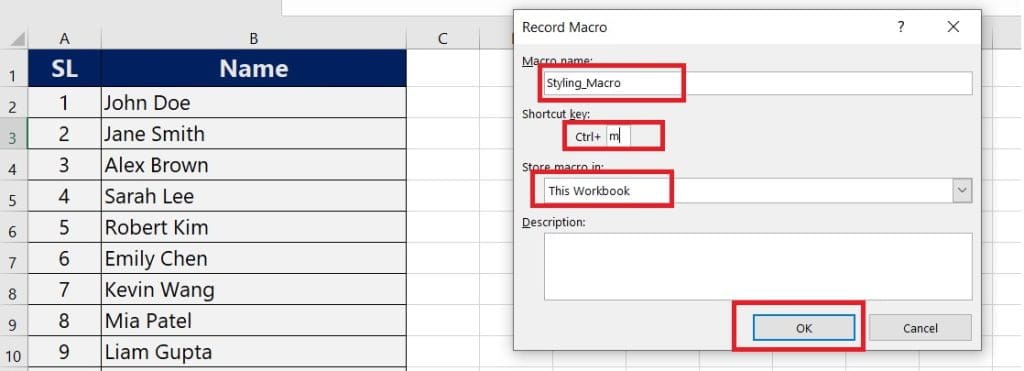
- Choose where to store the macro: either in your current workbook or in your personal macro workbook (recommended for reusability).
- Click “OK” to start recording.
How to Calculate Percentage in Excel : Step by Step excel formula with example
Excel Formulas
Step 3: Perform Actions
- Excel will start recording your actions. Perform the actions you want to automate while the macro is being recorded.
- For example, let’s say you want to format a range of cells. Select the range, apply formatting options like font style, size, or fill color.

Step 4: Stop Recording
- Once you’ve completed your actions, click on the “Stop Recording” button in the bottom left corner of the Excel window or go back to the “Developer” tab and click on “Stop Recording.”

Step 5: Test and Edit the Macro
- To test your macro, press the assigned shortcut key or go to the “Developer” tab and click on “Macros.”
- Select your macro from the list and click on “Run.”
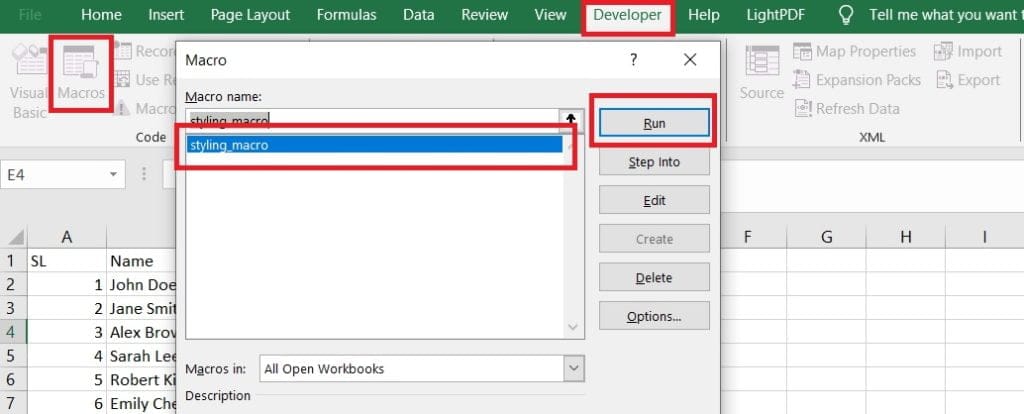
- If everything works as expected, great! If not, you can edit your macro by going back to the “Developer” tab, clicking on “Macros,” selecting your macro, and clicking on “Edit.”
Step 6: Assign Macro to a Button (Optional)
- To make your macro easily accessible, you can assign it to a button on the Excel ribbon or a specific cell.
- Go to the “Developer” tab and click on “Insert” in the “Controls” group.
- Choose the type of button you want to add (e.g., a form control button or an ActiveX control button).
- Click and drag to draw the button on your worksheet.
- In the “Assign Macro” dialog box, select your macro from the list and click “OK.”
Cheat Sheets
Step 7: Save Your Workbook
- Remember to save your workbook to preserve the macro. If you’re using a personal macro workbook, it will be available for use in any Excel file.
That’s it! You’ve successfully created a macro in Excel. Now, whenever you run the macro, it will perform the recorded actions automatically, saving you time and effort.
FAQ
Here are some frequently asked questions (FAQs) with answers related to the topic of mastering macros in Excel:
Q1: What is a macro in Excel?
A1: A macro in Excel is a recorded set of actions that can be replayed with a single click or assigned to a shortcut key. It allows users to automate repetitive tasks, streamline complex processes, and increase productivity.
Excel Templates
Q2: How do I enable the Developer tab in Excel?
A2: To enable the Developer tab, go to the “File” tab, click on “Options,” select “Customize Ribbon,” and check the box next to “Developer.” This will make the Developer tab visible in the Excel ribbon.
Q3: Can I create a macro without coding knowledge?
A3: Yes, Excel provides a built-in macro recorder that allows you to record your actions and generate code automatically. This means you can create macros without any coding knowledge. However, understanding basic programming concepts can help you modify and enhance macros further.
Q4: Can macros be edited or modified after recording?
A4: Yes, macros can be edited or modified after recording. You can access the Visual Basic Editor by going to the Developer tab and clicking on “Visual Basic” or by pressing ALT + F11. In the editor, you can view and modify the recorded code to add custom functionality or make changes to suit your specific needs.
Excel Formulas
Q5: How can I assign a shortcut key or button to run a macro?
A5: To assign a shortcut key, while recording the macro or in the Macros dialog box, you can specify a combination of keys that will trigger the macro. To assign a button, go to the Developer tab, click on “Insert” in the Controls group, select the type of button you want to add, draw it on your worksheet, and assign your macro to it using the Assign Macro dialog box.
Q6: Can macros be shared with others?
A6: Yes, macros can be shared with others by saving them in a shared workbook or by creating an add-in. However, it’s essential to ensure that the recipient understands and trusts the macro code, as malicious code can potentially harm the system.
Q7: Are there any risks associated with using macros in Excel?
A7: Macros can pose security risks if they are created or used without proper caution. It’s important to enable macro security settings and only run macros from trusted sources to prevent potential malware or unauthorized access to your system.
How to use conditional formatting in excel for Dynamic Spreadsheets!
Learn Excel
Q8: Can macros work with multiple worksheets or workbooks?
A8: Yes, macros can work with multiple worksheets or workbooks. By writing custom code or recording actions across different sheets or files, you can create macros that manipulate data, generate reports, or perform calculations across multiple locations.
Q9: Can I delete or disable a macro in Excel?
A9: Yes, you can delete or disable a macro in Excel. To delete a macro, go to the Developer tab, click on “Macros,” select the macro you want to delete, and click on “Delete.” To disable a macro temporarily without deleting it, you can comment out the code within the Visual Basic Editor.
Q10: Where can I find more resources to learn about advanced macro techniques in Excel?
A10: There are various online tutorials, forums, and books available that provide comprehensive guidance on advanced macro techniques in Excel. Additionally, Microsoft’s official documentation and support resources offer detailed information and examples for expanding your knowledge and skills in Excel macros.CopyAdd To Document
Free Course





